
Part II: The Message

Gurdjieff Teaching Students

Gurdjieff Teaching Students
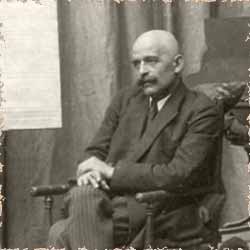
Gurdjieff Teaching
The Inner and Outer Meaning of Religious Teachings
[GURDJIEFF] “All religious teachings consist of two parts, the visible and the hidden. To be disappointed in religion means being disappointed in the visible, and to feel the necessity for finding the hidden and unknown part of religion.”i
In our age, we don’t obviously associate ‘religion’ with ‘teaching’. We don’t think of a church, mosque, or synagogue as a school. But throughout most of history, this was where learning occurred. Today, we associate going to church with an expression of faith, to receive moral instruction, or perhaps simply as a form of socializing. These outer or exoteric layers always existed, but beneath them lay a deeper inner, esoteric layer of learning. You had to penetrate through the outer layer to arrive at the inner one.

Gurdjieff Teaching
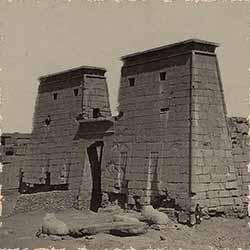
Karnak Temple, Thebes
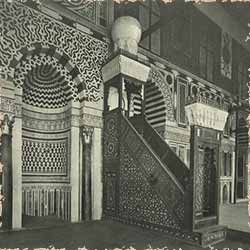
Mosque of Sultan al-Muayyad, Cairo

Esotericism in Temple Architecture
This principle of esotericism is expressed in religious architecture. Temples are divided into sections of varying degrees of sacredness. You enter at the least sacred part, and as you travel inward, the spaces become more holy. At the heart of every temple lies the most sacred place, the focal point of its architecture: the holy-of-holies.
[GURDJIEFF] “I had… the possibility of gaining access to the so-called “holy-of-holies” of nearly all hermetic organizations… inaccessible to the ordinary man, and of discussing and exchanging views with innumerable people who… were real authorities.”ii

Karnak Temple, Thebes
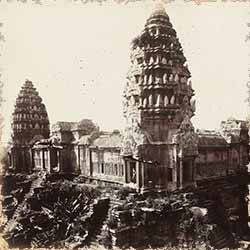
Angkor Wat, Cambodia
The teachings of the outer circle of religion always speak of an external god or gods that govern the world we inhabit. Jehovah in Judaism; Brahman in Hinduism; Zeus in Ancient Greece; Allah in Islam. The focus is on our proper relation to those gods, the forms of worship that invoke them, and the behavior that pleases or displeases them. The outer meaning also delivers a moral code by which its community of believers should abide.
The outer meaning speaks of the outer world, the macro-cosmos. The inner meaning speaks of the human being, the micro-cosmos. So when religious texts refer to a god as the highest power in the universe, their inner meaning is referring to the highest power within the human being. When religious texts speak of a devil as an evil force bent on deviating humankind from the right way, their inner meaning is speaking of human weaknesses, or habits. When religious texts speak of government, their inner meaning is referring to self-government. In other words, when you shift from the outer to the inner meaning of religious texts, you transition from religion to psychology.

Mosque of Sultan Al-Muayyad, Cairo
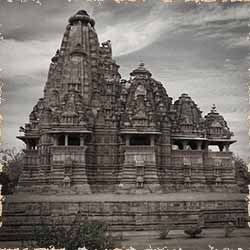
Vishvanath Temple, Kajurahu

Angkor Wat, Cambodia

Vishvanath Temple, Kajurahu


Gurdjieff Teaches Psychological Development
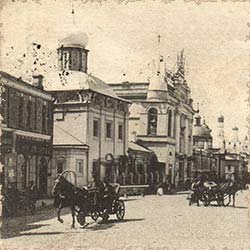
Varvarka Street, Moscow
Gurdjieff’s External Challenges
Gurdjieff begins by presenting his teaching to people drawn to mysticism, spirituality, or psychology. This is first done through casual discussions in cafes, and later in more formal lectures. Throughout these lectures, he always stresses that real change will require more organized work. Lectures are, at best, preparatory. From the very beginning, when he meets his first Russian students in 1912, Gurdjieff speaks of formalizing his work, of raising funds to buy equipment, and of eventually hiring a permanent place. But the political environment of Russia prevents this.
[GURDJIEFF] “Russia at that time was peaceful, rich and quiet… the unexpected and catastrophic events of the World War destroyed it at the very height of its earlier activities.”ii
Russia is about to experience atrocities on an unprecedented scale: World War I, followed by a revolution and civil war. War is, unarguably, the most extreme display of human irrationality, of what Gurdjieff called ‘sleep’ and ‘mass hypnosis’. A handful of politicians can’t reach an agreement over a table, and hundreds of thousands of soldiers from one side must now kill hundreds of thousands of soldiers from another.
From the very outset of his teaching, Gurdjieff will have to adapt to incredibly exacting circumstances, sometimes even life-threatening. On the other hand, this extreme display of human conflict forms a perfect canvas for his presentation. Why can’t wars be stopped? Why can’t people see the obvious? Why does humankind have to keep repeating its mistakes?

Varvarka Street, Moscow

Bolshevik Army Marching Through the Streets of Moscow

Bolshevik Army marching through the streets of Moscow



Micro-Cosmos Human as Three-Brained Being
The Three Brains of the Human Being
[GURDJIEFF] “The general psyche of… man is split into three… completely independent ‘entities’, which bear no relation to each other and which are separate both in their functions and in their manifestations…”i
Gurdjieff calls these entities ‘brains’ or ‘centers’ because they govern all our actions. One is the mind, responsible for association, comparison, abstraction, categorization, and conceptualization. Another is the heart, responsible for fear, anxiety, care, sensitivity, compassion, and processing various other emotional impressions. And the third is the body, responsible for physical impulses, sense-perception, hunger, pain, pleasure, movement, and spatial orientation.
[JOHN BENNETT] “We made many experiments and observations in order to satisfy ourselves that the notion of three centers was valid.”v
[PETER OUSPENSKY] “Gurdjieff gave the ideas little by little, as though defending or protecting them from us. When touching on new themes for the first time he gave only general principles, often holding back the most essential… On the question of centers for instance, he first spoke of three centers, the intellectual, the emotional, and the moving, and tried to make us distinguish these functions, find examples, and so on. Afterward the instinctive center was added, as an independent and self-supporting machine. Afterward the sex center.”i

Micro-Cosmos Human as Three-Brained Being
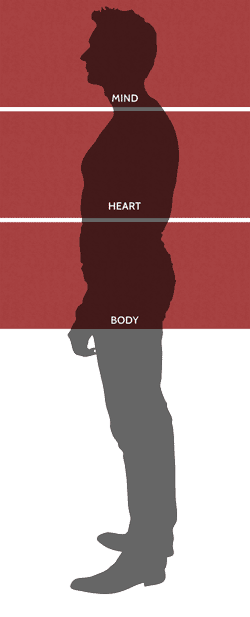
Micro-Cosmos Human as Three-Brained Being

Micro-Cosmos Human as Three-Brained Being
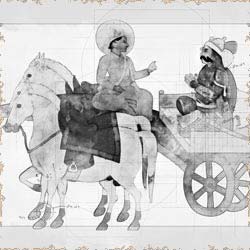
Arjuna with Horse, Carriage, and Driver
This terminology is Hindu. The analogy is featured in the Vedas and later elaborated upon in the Upanishads. This reveals Gurdjieff was familiar with the inner meaning of Hinduism, which he and his Seekers of Truth could have learned in Indian schools and Tibetan Monasteries.
The symbolism of horse, carriage, and driver, is hidden by being placed in an historical context. Before the Kurukshetra War in the Mahabharata, Arjuna is seated on a carriage harnessed to horses, engaging in dialog with his driver, Krishna. And in Buddhism, when Prince Siddhartha ventures outside his palace, he mounts a carriage drawn by four horses, led by his driver Chandaka. Thus placed as secondary details of important historical events, the esoteric significance of horse, carriage, and driver, are easily overlooked.
One might think that the inner circle possesses knowledge hidden from the outer circle. In fact, both inner and outer circles use the same knowledge. They differ in its interpretation.
So if the psyche of the human being is divided into three independent brains, this accounts for our perpetually contradicting ourselves. It accounts for our difficulty understanding ourselves because each brain speaks in a different language. And on a larger scale, it accounts for why mankind — made out of the sum of non-unified people — is destined to live in a ‘confusion of tongues’, never understanding each other and always ending up in conflict.

Arjuna with Horse, Carriage, and Driver
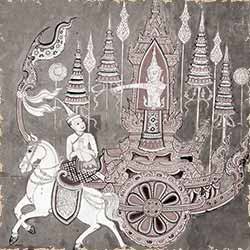
Siddhartha with Horse, Carriage, and Driver

Siddhartha with Horse, Carriage, and Driver


Lack of Unity in the Human Being
Thus, the psychology taught in the inner meaning of ancient teachings approaches human beings as incomplete. Nature brings us only to a certain point, beyond which we must work to fulfill our innate potential. As long as we remain undeveloped, there is a random relation between our three brains and their many impulses. There is no unified governing element, no master to command the driver to discipline the horse and guide the carriage.
We are easily influenced, deeply prone to suggestibility. Our thoughts and emotions do not belong to us. They are programmed into us through upbringing and education. We lend them an air of individuality, as though we intend to think and feel the way we do, but in truth we are marionettes. The strings that govern our actions do not lie in our hands.
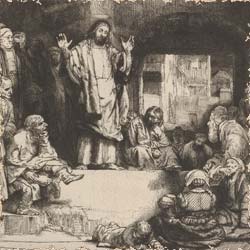
Jesus Preaches to the Multitudes, Rembrandt
In the Gospel of Mark, Jesus confronts a man possessed by demons and asks his name. The man replies, “My name is legion, for we are many.” So the inner meaning of being possessed by demons is being enslaved to every inner impulse. This suggests Gurdjieff was also familiar with the inner meaning of Christianity, perhaps from his travels to Cappadocia or Mount Athos.
The outer meaning considers being possessed by demons to be a rare exception, an unfortunate freak of nature that must quickly be healed. The inner meaning affirms all human beings to be possessed by demons. All suffer from lack of inner unity, all lack a governing element, all have no permanent ‘I’. Now a strong physical impulse directs us — hunger, fatigue, sexual desire — then an emotional impulse replaces it — guilt, self-pity, or the need to be appreciated — and then a mental impulse replaces that — curiosity, disagreement, fantastic daydreaming — without end.
The majority of people will never admit to themselves that this is how their inner world functions. We call our daydreaming, ‘thinking’. We call our negative emotions, ‘sincerity’. We pretend to have intention behind our actions. We pretend to be conscious, to be unified.
This compounds our difficulty, for not only do we lack unity, we are also ignorant of our lack of unity; not only are we slaves to our inner impulses, we are also enslaved unawares. As long as we pretend to possess self-government, we will never make the efforts required to achieve it.

Jesus Preaches to the Multitudes, Rembrandt
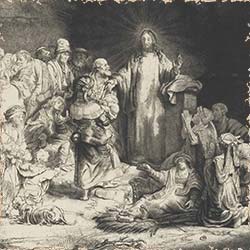
Jesus Heals the Sick, Rembrandt

Jesus Heals the Sick, Rembrandt


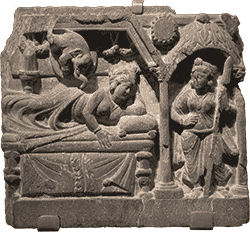
Queen Maya Conceives Siddhartha
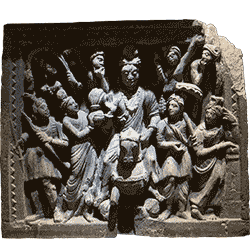
Siddhartha’s Departure from the Palace
The Psychological Prison of the Human Being
[PETER OUSPENSKY] “Gurdjieff often returned… to this example of “prison” and “escape from prison” in his talks. Sometimes he began with it, and then his favorite statement was that, if a man in prison was at any time to have a chance of escape, then he must first of all realize that he is in prison.”i
Prince Siddhartha is born and raised in a prison, without realizing it. His father the king encloses him there from birth to prevent him from becoming exposed to the suffering in life and pondering its meaning.

Queen Maya Conceives Siddhartha
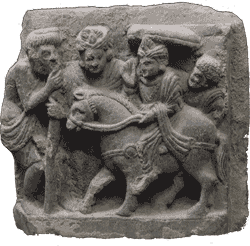
Siddhartha Encountering Old Age
Episodes from the life of the Buddha lined the walls of early Buddhist temples, some of which may well have been standing when the Seekers of Truth visited places like Afghanistan in the end of the 19th century. Scenes of his mother’s auspicious conception, the birth, the first seven steps, the gradual realization of being imprisoned — all the way to enlightenment under the Bodhi tree.
The movement through such a temple becomes a reenactment of the life of Prince Siddhartha. On the level of the outer meaning, the worshiper is learning the story of the life of the founder of Buddhism. On the level of the inner meaning, the practitioner is learning the steps that lead from imprisonment to liberation.

Siddhartha’s Departure from the Palace
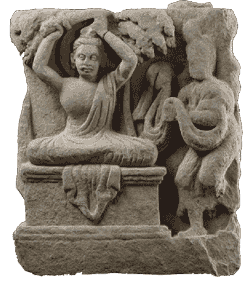
Siddhartha Renouncing the World

Siddhartha Encountering Old Age

Siddhartha Renouncing the World


Gurdjieff Teaches in Finland and Essentuki
By 1916, a small core of serious pupils have gathered around Gurdjieff in Moscow and St. Petersburg. Gurdjieff takes eight of them to a country house in Finland for more concentrated work.
[GURDJIEFF] “A man is unable to keep watch on the whole of himself… Only school can do this, school methods, school discipline — a man is much too lazy, he will do a great deal without the proper intensity, or he will do nothing at all while thinking that he is doing something.”i
Another experiment in more organized group work occurs in 1917, when Gurdjieff collects 13 of his first Russian students for six weeks at Essentuki, at the base of the Caucasus mountains in Russia. Ouspensky gives a personal report of this in his book In Search of the Miraculous, singling it out as a pivotal moment in his understanding and development.
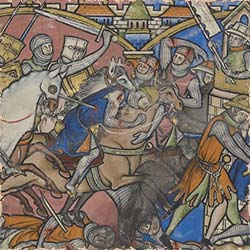
Israel in Civil War

King David as Deputy Steward
Introducing Inner Order in the Human Being
[GURDJIEFF] “In one teaching, man is compared to a house in which there is a multitude of servants but no master and no steward. The servants have all forgotten their duties; no one wants to do what he ought; everyone tries to be master, if only for a moment; and, in this kind of disorder, the house is threatened with grave danger.”i
One of the most well-known examples of this analogy — carefully hidden under a coat of an outer meaning — comes from the Old Testament, from the progression of Israel from twelve warring tribes to a united kingdom. Rather than a disordered house, it speaks of a disordered country. The tribes share in common only their ancestry and belief, but in all other respects differ, just like we are seemingly united by possessing a single body and name, though we are full of contradictions.
“In those days there was no king in Israel,” says the Book of Judges of Israel at that point in time; “Every man did that which was right in his own eyes.”
[GURDJIEFF] “The only chance of salvation is for a group of the more sensible servants to meet together and elect a temporary steward, that is, a deputy steward.”i

Israel in Civil War
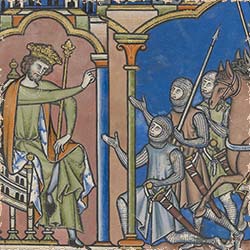
King Saul as Observing ‘I’
And indeed, the elders of each tribe convene to find a king. They anoint Saul to be the first king of Israel. He represents Observing ‘I’. Saul is succeeded by David, who represents Deputy Steward.
[GURDJIEFF] “Deputy steward can then put the other servants in their places, and make each do his own work: the cook in the kitchen, the coachman in the stables, the gardener in the garden, and so on. In this way the ‘house’ can be got ready for the arrival of the real steward who will, in his turn, prepare it for the arrival of the master.”i
In the Bible, ‘Master’ or ‘Lord’ are interchangeable with ‘God.’ So when King Solomon erects a temple in Jerusalem and achieves a permanent connection with God, this symbolizes establishing a permanent connection with a Master; the fulfillment of the highest potential in the micro-cosmos human being.

King David as Deputy Steward
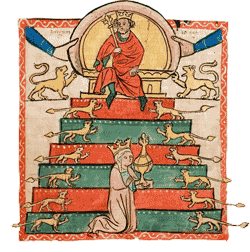
King Solomon on Throne as Steward

King Saul as Observing ‘I’

King Solomon on Throne as Steward


Gurdjieff on Attaining Unity
[GURDJIEFF] “A man who has reached the full development possible possesses… will, consciousness, permanent and unchangeable I, individuality… and many other properties which in our blindness and ignorance we ascribe to ourselves.”i
Ultimately, Gurdjieff came to teach how to find the God within, not in a religious, sentimental way, but through scientific, measurable efforts. Specifically, the effort of self-remembering.
[JOHN BENNETT] “The word zikr literally means ‘remembering,’ which in Gurdjieff’s presentation is the means to ‘remembering oneself.’ The special characteristic of the Sufi zikr is the invocation of the Name of God. It is a directing of the intention and the will toward the Deity within.”v
Self-Remembering
[GURDJIEFF] “When you become aware not only of what you are doing but also of yourself doing it, you see both ‘I’ and the ‘here’ of ‘I am here.’ This is self-remembering… Try to remember yourselves when you observe yourselves and later on tell me the results. Only those results will have any value that are accompanied by self-remembering.”iv
[PETER OUSPENSKY] “The very first attempts… at self-remembering failed to give any results except to show me that in actual fact we never remember ourselves.”i
[JOHN BENNETT] “We soon realized that we were quite unable to remember ourselves voluntarily for more than a minute or two at a time. I struggled desperately hard. This was my first experience of ‘work on myself,’ and it opened a new world for me. I began to see for the first time what Gurdjieff had meant when he said… that it was not enough to know, but that one also had to be.”vi
[CHARLES NOTT] “Self-remembering is so simple, yet, at the same time, so difficult. Why? Because the whole of life, together with things in ourselves, is in a conspiracy to make us forget, to keep us in a state of sleep.”vii
[JEANNE DE SALZMANN] “This is the liberation that Gurdjieff speaks of. It is the aim of all schools, all religions… In the experience “I Am,” I open to the divine, the infinite beyond space and time, the higher force that religions call God.”viii
So behind Gurdjieff’s presentation of the macro-cosmos universe and the micro-cosmos human being lies the effort of self-remembering, an effort to be applied always and everywhere. This makes Gurdjieff’s teaching refreshingly practical. While so many other teachings present theories that refute other theories, Gurdjieff did not come to teach a new theory of awakening. He came to teach his pupils to be able to Be.
Frequently Asked Questions
What did Gurdjieff teach?
1. To awaken individuals to the reality of their mechanicality.
2. To ‘die’ to it, in the sense of renouncing the internal forces that power it.
3. And to be reborn into conscious, unified beings.
Key ideas from his teaching include:
– We have three brains: intellectual, emotional, and physical (or moving). These brains are disconnected and often in conflict.
– We don’t have a single and unified ‘I’. Rather, these three brains continually generate impulses that call themselves ‘I’ and speak in the name of the whole.
– We are not conscious of these divisions and dynamics within us.
– It is possible to become conscious of our condition through methodical work. It is possible to create a real and indivisible ‘I’ through intelligent efforts.
What is the Gurdjieff Work (or Fourth Way)?
Gurdjieff’s work involves:
– Self-observation: watching oneself impartially, as one would observe someone else. This self-observation must be guided by knowledge of the divisions of our psyche.
– Self-remembering: the effort to be aware of ‘I’ and ‘here’ always and everywhere.
– Working with others: group work accelerates our learning by exposing us to many more observations, as well as presses us against the challenge of getting along with others.
– Conscious suffering: struggling between competing desires or impulses. Willingly enduring discomfort to break our habitual patterns.
What is the philosophy of the Fourth Way?
– The universe is governed by laws (like the Law of Three and Law of Seven). Although human beings are born and raised ignorant of these laws, under special conditions they are able to comprehend and learn to observe these laws in action.
– Mankind in general is positioned in a difficult place in the universe, under many mechanical laws that keep people imprisoned in a state of hypnotic sleep.
– This ‘difficult place’ is not unfortunate. It is necessary, for only by working methodically to break free, can individual humans fulfill their potential. In other words, this fulfillment must be earned by their own labor. It cannot be given to them for free.
– Escaping from this prison cannot be accomplished by single individuals. They need help from those who’ve escaped before.
What does self-observation mean in Gurdjieff's teaching?
The aim is to create a gap between “I” and our emotions, thoughts, and physical impulses. This effort differs from introspection. When we introspect, we analyze past behavior through the lens of our current state. When we self-observe, we witness present behavior without analysis. This distinction is crucial because analysis is colored by our current state, whereas observation creates the possibility of seeing oneself objectively.
Gurdjieff emphasized that self-observation reveals that we generally “do not remember ourselves.” Self-observation eventually reveals that we do not actually “do” things—things happen to us. We don’t control our thoughts, emotions, or movements as we imagine. This painful revelation is necessary before any real change can occur.
Gurdjieff insisted that proper self-observation requires others to reflect aspects of ourselves we cannot see, and a teaching framework that directs our attention to specific areas of observation—which is why he emphasized that only school work enables complete self-observation.
How does Gurdjieff's teaching relate to esoteric traditions?
– All religions have outer (exoteric) and inner (esoteric) meanings.
– Esoteric truth is often hidden in myths, rituals, and symbols, accessible only to those who have prior preparation and are able to access their inner meaning.
– Religious texts are maps of inner psychology rather than mere historical accounts.
– One’s ability to understand esoteric texts depends on one’s own experience in this work (also expressed as one’s ‘level of being’).
Who were Gurdjieff's main students?
– Peter D. Ouspensky
Authored In Search of the Miraculous (seminal intro to Gurdjieff’s ideas).
Later gave independent lectures in London.
– Jeanne de Salzmann
Longest-standing student.
Carried the work forward through the Gurdjieff Foundations.
Authored The Reality of Being.
– John G. Bennett
Authored Witness and Gurdjieff: Making a New World.
Explored connections to Sufism and other traditions.
– Thomas & Olga de Hartmann
Close companions. Co-created Gurdjieff’s music.
Authored Our Life with Mr. Gurdjieff.
– Charles Stanley Nott
Authored Teachings of Gurdjieff: A Pupil’s Journal.
These students preserved and developed the Work after Gurdjieff’s death, ensuring it remained a living tradition.
Sources
- In Search of the Miraculous by Peter Deminaovich Ouspensky
- The Herald of the Coming Good by George Ivanovich Gurdjieff
- Beelzebub’s Tales to His Grandson by George Ivanovich Gurdjieff
- Views from the Real World by George Ivanovich Gurdjieff
- Gurdjieff: Making a New World by John Godolphin Bennett
- Witness by John Godolphin Bennett
- Teachings of Gurdjieff: A Pupil’s Journal by Charles Stanley Nott
- The Reality of Being: The Fourth Way of Gurdjieff by Jeanne de Salzmann

Part I:
Gurdjieff
Part III:
The School
Part IV:
Initiation
Part V:
Fourth Way